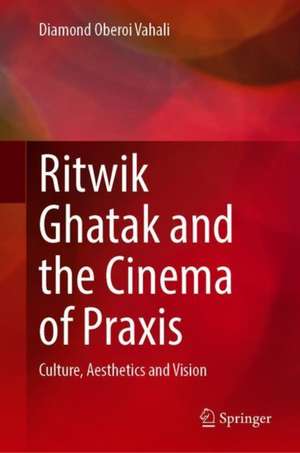Ritwik Ghatak and the Cinema of Praxis: Culture, Aesthetics and Vision
Autor Diamond Oberoi Vahalien Limba Engleză Hardback – 25 apr 2020
In a significant departure from other works on Ritwik Ghatak, this book establishes him as an auteur and a maestro on par with some of the great film directors, like Sergei Eisenstein, Satyajit Ray, Ingmar Bergman, Federico Fellini, Kenji Mizoguchi and Luis Bunuel. Based on in-depth research that follows Ghatak’s journey within the context of the Indian People’s Theatre Association, it fills an important gap in the scholarship around Ghatak by offering crucial insights into Ghatak’s unique vision of cinema embedded as it is in the cultural psychic configurations of the people. It analyses Ghatak’s practice by minutely tracing formal similarities across the language of his cinematic oeuvre in the domain of cinematography, lighting, music, and sound. The book develops the way in which cinematic technique enters the domain of conceptual constructs and abstractions. It moves on to chronicle Ghatak’s political odyssey as reflected in his cinema. Moreover, it charts the manner in whichGhatak, through his cinematic idiom, offers a polemic of cinema that further adds to his notion of praxis – a thoughtful Marxist paradigm organically associated with the culture and context of India. By locating Ghatak within the discourse of nationalism, the book brings to the surface Ghatak’s critical insights related to the independence of the nation and the trauma of the partition of Bengal. Ghatak’s cinema served the crucial function of chronicling the mass tragedy of partition and its impact on the human psyche.
This book appeals to scholars of film studies and filmmaking as well as to researchers and general readers interested in debates pertaining to culture, politics, art, psychoanalysis, partition and refugee studies, cinema, theatre, and ideology.
| Toate formatele și edițiile | Preț | Express |
|---|---|---|
| Paperback (1) | 372.27 lei 38-44 zile | |
| Springer Nature Singapore – 25 apr 2021 | 372.27 lei 38-44 zile | |
| Hardback (1) | 375.45 lei 38-44 zile | |
| Springer Nature Singapore – 25 apr 2020 | 375.45 lei 38-44 zile |
Preț: 375.45 lei
Nou
Puncte Express: 563
Preț estimativ în valută:
71.85€ • 74.74$ • 59.32£
71.85€ • 74.74$ • 59.32£
Carte tipărită la comandă
Livrare economică 11-17 aprilie
Preluare comenzi: 021 569.72.76
Specificații
ISBN-13: 9789811511967
ISBN-10: 9811511969
Pagini: 242
Ilustrații: XIX, 242 p. 1 illus.
Dimensiuni: 155 x 235 x 20 mm
Greutate: 0.5 kg
Ediția:1st ed. 2020
Editura: Springer Nature Singapore
Colecția Springer
Locul publicării:Singapore, Singapore
ISBN-10: 9811511969
Pagini: 242
Ilustrații: XIX, 242 p. 1 illus.
Dimensiuni: 155 x 235 x 20 mm
Greutate: 0.5 kg
Ediția:1st ed. 2020
Editura: Springer Nature Singapore
Colecția Springer
Locul publicării:Singapore, Singapore
Cuprins
Introduction.- The Man and his Times.- A Search for a Personal Vision of Cinema.- Indian People’s Theatre Association and the Cinema of Social Transformation.- The Episodic Structure in Ghatak’s Cinema.- The Magnum Opus of the Bengal Partition: Motifs and Antinomies.- Recasting the Contemporary in the Crucible of the myth: Interventions and Interpretations.- Cinematography, Lighting, Sound and Music: A Contrapuntal Melody.- Film and Praxis: A Political Odyssey.- Marxism, Culture and Praxis.- The Angst of an Artist.- Survival and Resilience.
Notă biografică
Diamond Oberoi Vahali teaches literature and cinema at the School of Letters, and the School of Undergraduate Studies at Ambedkar University Delhi, where she is an Associate Professor. She completed her Ph.D. at Jawaharlal Nehru University’s School of Language, Literature and Culture Studies. She co-edited and co-authored Once Upon a Time: A collection of Short Stories; and Life and Times of Shanta Toofani: Story of a Survivor. She has published articles on various aspects of literature and cinema. Her interests include literature, cinema studies, psychoanalysis, the human condition, empathetic and experiential pedagogies, engaged spirituality, life writing and memory studies, folk, oral and indigenous cultures, and narratives of resistance and resilience
Textul de pe ultima copertă
In a significant departure from other works on Ritwik Ghatak, this book establishes him as an auteur and a maestro on par with some of the great film directors, like Sergei Eisenstein, Satyajit Ray, Ingmar Bergman, Federico Fellini, Kenji Mizoguchi and Luis Bunuel. Based on in-depth research that follows Ghatak’s journey within the context of the Indian People’s Theatre Association, it fills an important gap in the scholarship around Ghatak by offering crucial insights into Ghatak’s unique vision of cinema embedded as it is in the cultural psychic configurations of the people. It analyses Ghatak’s practice by minutely tracing formal similarities across the language of his cinematic oeuvre in the domain of cinematography, lighting, music, and sound. The book develops the way in which cinematic technique enters the domain of conceptual constructs and abstractions. It moves on to chronicle Ghatak’s political odyssey as reflected in his cinema. Moreover, it charts the manner in whichGhatak, through his cinematic idiom, offers a polemic of cinema that further adds to his notion of praxis – a thoughtful Marxist paradigm organically associated with the culture and context of India. By locating Ghatak within the discourse of nationalism, the book brings to the surface Ghatak’s critical insights related to the independence of the nation and the trauma of the partition of Bengal. Ghatak’s cinema served the crucial function of chronicling the mass tragedy of partition and its impact on the human psyche.
This book appeals to scholars of film studies and filmmaking as well as to researchers and general readers interested in debates pertaining to culture, politics, art, psychoanalysis, partition and refugee studies, cinema, theatre, and ideology.
Caracteristici
Establishes Ritwik Ghatak as an auteur of cinema Discusses the partition of Bengal and its cinematic representation Historicises Ghatak within the dynamics and context of the Indian People’s Theatre Association and their intervention in Indian cinema
